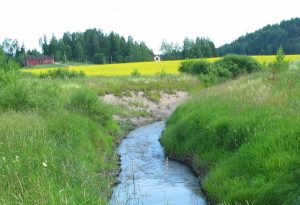In this post, Ralf Schäfer talks about their recently published paper “Large scale risks from agricultural pesticides in small streams”.

Small streams in agricultural areas are particularly at risk of pesticide input (photo by R. B. Schäfer)
Small streams comprise the major part of the stream network and host a higher beta diversity than larger systems, i.e. the species composition between small streams differs more strongly. At the same time, small streams in the agricultural landscape might be particularly susceptible to pesticide contamination given their low dilution potential.
The National Action Plan on the Sustainable Use of Plant Protection Products (NAP) aims to reduce risks to humans, animals and the environment. The German NAP also addresses the knowledge gap concerning pesticide exposure in small streams. The working group Quantitative Landscape Ecology is one of the scientific partners that has been tasked by the German Environment Agency to devise a national pesticide monitoring of small streams and evaluate the current situation based on governmental monitoring data.
In the article we present our evaluation of the pesticide pollution of small streams. We compiled the largest pesticide data set for Germany and, using novel statistical methods that allow accounting for non-detects, found that agricultural land use, rain events and seasonal dynamics were main drivers of pesticide risks in small streams. Risk thresholds were exceeded in 26% of streams, with the highest exceedances found for neonicotinoid insecticides. However, the sampling methods used were not tailored to capture episodic pesticide pollution and the real situation is likely worse.
The paper authored by Eduard Szöcs, Marvin Brinke, Bilgin Karaoglan and Ralf B. Schäfer was published in Environmental Science and Technology.
